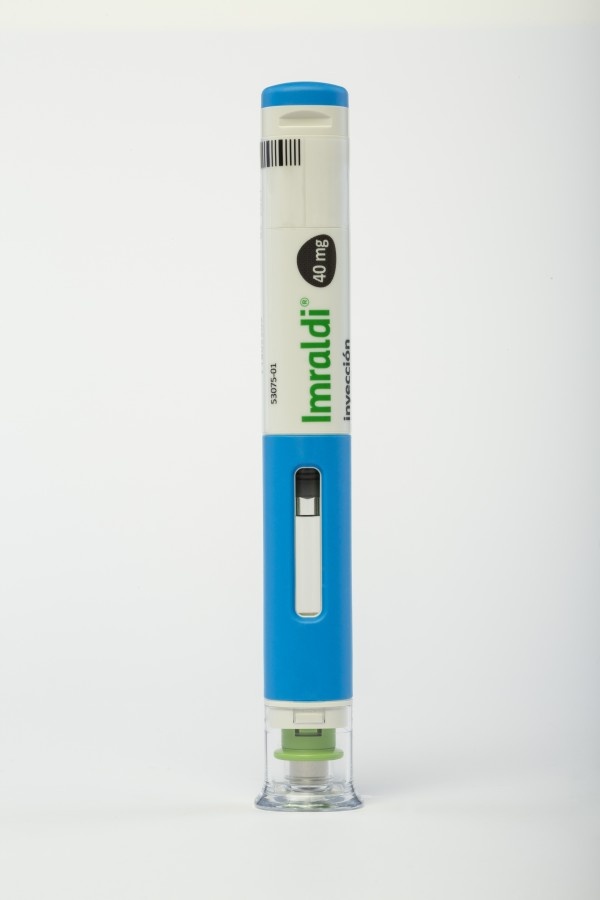
Инструкция по применению ИМРАЛДИ 40 мг РАСТВОР ДЛЯ ИНЪЕКЦИЙ В ПРЕДНАПОЛНЕННОМ ШПРИЦ-РУЧКЕ
Введение
Прошпект: информация для пациента
Имралди 40 мг раствор для инъекций в предварительно заполненном шприце
адалимумаб
Прочитайте внимательно весь прошпект перед началом использования этого лекарства, поскольку он содержит важную информацию для вас.
- Сохраните этот прошпект, поскольку вам может потребоваться перечитать его.
- Ваш врач также предоставит вам карту информации для пациента, содержащую важную информацию о безопасности, которую вам необходимо знать до и во время лечения Имралди. Сохраните эту карту информации для пациента во время лечения и в течение 4 месяцев после последней инъекции (или вашего ребенка) Имралди.
- Если у вас есть какие-либо вопросы, проконсультируйтесь с вашим врачом или фармацевтом.
- Это лекарство было назначено только вам и не должно быть передано другим людям, даже если они имеют те же симптомы, что и вы, поскольку оно может нанести им вред.
- Если вы испытываете побочные эффекты, проконсультируйтесь с вашим врачом или фармацевтом, даже если это побочные эффекты, которые не указаны в этом прошпекте. См. раздел 4.
Содержание прошпекта
- Что такое Имралди и для чего он используется
- Что вам нужно знать перед началом использования Имралди
- Как использовать Имралди
- Возможные побочные эффекты
- Хранение Имралди
- Содержание упаковки и дополнительная информация
- Инструкции по применению
1. Что такое Имралди и для чего он используется
Имралди содержит активное вещество адалимумаб, лекарство, которое действует на иммунную систему (систему защиты) вашего организма.
Имралди показан для лечения:
- ревматоидного артрита,
- ювенильного идиопатического полиартрита,
- артрита, ассоциированного с энтезитом,
- анкилозирующего спондилита,
- аксиального спондилоартрита без радиографических признаков анкилозирующего спондилита,
- псориатического артрита,
- псориаза,
- гидраденита,
- болезни Крона,
- язвенного колита и
- неинфекционного увеита.
Активное вещество Имралди, адалимумаб, является моноклональным антителом. Моноклональные антитела - это белки, которые связываются с конкретной мишенью.
Мишенью адалимумаба является белок (фактор некроза опухоли (ФНОа), уровень которого увеличивается при воспалительных заболеваниях, указанных выше. Связываясь с ФНОа, Имралди уменьшает процесс воспаления при этих заболеваниях.
Ревматоидный артрит
Ревматоидный артрит - это воспалительное заболевание суставов.
Имралди используется для лечения ревматоидного артрита у взрослых. Если вы страдаете активным ревматоидным артритом средней или тяжелой степени, вам могут быть назначены другие лекарства, модифицирующие заболевание, такие как метотрексат. Если эффект этих лекарств не достаточно хорош, вам будет назначен Имралди для лечения ревматоидного артрита.
Имралди также может быть использован для лечения тяжелого, активного и прогрессирующего ревматоидного артрита без предыдущего лечения метотрексатом.
Имралди может уменьшить повреждение суставов и костей, вызванное заболеванием, и улучшить физическую активность.
Обычно Имралди используется в сочетании с метотрексатом. Если ваш врач считает, что метотрексат не подходит, Имралди может быть назначен в одиночку.
Ювенильный идиопатический полиартрит и артрит, ассоциированный с энтезитом
Ювенильный идиопатический полиартрит и артрит, ассоциированный с энтезитом, - это воспалительные заболевания суставов, которые обычно появляются в детстве.
Имралди используется для лечения ювенильного идиопатического полиартрита у детей и подростков в возрасте от 2 до 17 лет и артрита, ассоциированного с энтезитом, у детей в возрасте от 6 до 17 лет. Пациенты могут были получали другие лекарства, модифицирующие заболевание, такие как метотрексат. Если эффект этих лекарств не достаточно хорош, пациентам будет назначен Имралди для лечения ювенильного идиопатического полиартрита или артрита, ассоциированного с энтезитом.
Анкилозирующий спондилит и аксиальный спондилоартрит без радиографических признаков анкилозирующего спондилита
Анкилозирующий спондилит и аксиальный спондилоартрит без радиографических признаков анкилозирующего спондилита - это воспалительные заболевания, которые поражают позвоночник.
Имралди используется для лечения анкилозирующего спондилита и аксиального спондилоартрита без радиографических признаков анкилозирующего спондилита у взрослых. Если у вас анкилозирующий спондилит или аксиальный спондилоартрит без радиографических признаков анкилозирующего спондилита, вы будете сначала лечены другими лекарствами, и если эффект этих лекарств не достаточно хорош, вам будет назначен Имралди для уменьшения симптомов и признаков вашего заболевания.
Псориатический артрит
Псориатический артрит - это воспалительное заболевание суставов, ассоциированное с псориазом.
Имралди используется для лечения псориатического артрита у взрослых. Имралди может уменьшить повреждение суставов, вызванное заболеванием, и улучшить физическую активность.
Псориаз в виде бляшек у взрослых и детей
Псориаз в виде бляшек - это воспалительное заболевание кожи, которое вызывает красные, чешуйчатые, с корками и покрытые серебристыми чешуйками области. Псориаз в виде бляшек также может поражать ногти, вызывая их разрушение, утолщение и отслоение от ногтевого ложа, что может быть болезненным. Считается, что псориаз вызван дефектом иммунной системы организма, который приводит к увеличению производства клеток кожи.
Имралди используется для лечения псориаза в виде бляшек средней или тяжелой степени у взрослых. Имралди также используется для лечения псориаза в виде бляшек тяжелой степени у детей и подростков с весом 30 кг или более, которые не ответили на местную терапию и фототерапию.
Гидраденит у взрослых и подростков
Гидраденит (иногда называемый обратным акне) - это долгосрочное и часто болезненное воспалительное заболевание кожи. Симптомы могут включать чувствительные узлы (бугорки) и абсцессы (фурункулы), которые могут выделять гной. Обычно поражаются определенные области кожи, такие как под грудью, в подмышках, внутренней части бедер, паху и ягодицах. Также могут быть рубцы в пораженных областях.
Имралди используется для лечения гидраденита у взрослых и подростков старше 12 лет. Имралди может уменьшить количество узлов и абсцессов, а также боль, обычно ассоциированную с вашим заболеванием. Вы можете были получали другие лекарства ранее. Если эффект этих лекарств не достаточно хорош, вам будет назначен Имралди.
Болезнь Крона у взрослых и детей
Болезнь Крона - это воспалительное заболевание пищеварительного тракта.
Имралди используется для лечения болезни Крона у взрослых и детей в возрасте от 6 до 17 лет. Если вы страдаете болезнью Крона, вы будете сначала лечены другими лекарствами. Если эффект не достаточно хорош, вам будет назначен Имралди для уменьшения симптомов и признаков болезни Крона.
Язвенный колит у взрослых и детей
Язвенный колит - это воспалительное заболевание толстой кишки.
Имралди используется для лечения язвенного колита средней или тяжелой степени у взрослых и детей в возрасте от 6 до 17 лет. Если вы страдаете язвенным колитом, вам могут быть назначены другие лекарства. Если эффект не достаточно хорош, вам будет назначен Имралди для уменьшения симптомов и признаков вашего заболевания.
Неинфекционный увеит у взрослых и детей
Неинфекционный увеит - это воспалительное заболевание, которое поражает определенные части глаза. Имралди используется для лечения
- взрослых с неинфекционным увеитом с воспалением, которое поражает заднюю часть глаза.
- детей старше 2 лет с хроническим неинфекционным увеитом с воспалением, которое поражает переднюю часть глаза.
Это воспаление может привести к снижению зрения и/или появлению мушек в глазу (черных точек или тонких линий, движущихся вдоль поля зрения). Имралди действует, уменьшая это воспаление.
2. Что вам нужно знать перед началом использования Имралди
Не используйте Имралди
- Если вы аллергичны к адалимумабу или любому другому компоненту этого лекарства (перечисленному в разделе 6).
- Если у вас есть тяжелая инфекция, включая туберкулез (см. «Предостережения и меры предосторожности»). Если у вас есть симптомы любой инфекции, например: температура, раны, усталость, проблемы с зубами, важно сообщить об этом вашему врачу.
- Если у вас есть умеренная или тяжелая сердечная недостаточность. Важно, чтобы вы рассказали врачу, если у вас были или есть серьезные проблемы с сердцем (см. «Предостережения и меры предосторожности»).
Предостережения и меры предосторожности
Проконсультируйтесь с врачом или фармацевтом перед началом использования Имралди.
Аллергическая реакция
- Если у вас есть аллергическая реакцияс симптомами, такими как сдавление в груди, затруднение дыхания, головокружение, отек или сыпь, прекратите введение Имралди и немедленно свяжитесь с врачом, поскольку в редких случаях эти реакции могут представлять угрозу для жизни.
Инфекция
- Если у вас есть любая инфекция, включая хроническую или локализованную (например, язву на ноге), проконсультируйтесь с врачом перед началом лечения Имралди. Если вы не уверены, свяжитесь с врачом.
- При лечении Имралди вы можете с большей легкостью заразиться инфекциями. Этот риск может быть выше, если уменьшается активность ваших легких. Эти инфекции могут быть тяжелыми и включать туберкулез, вирусные, грибковые, паразитарные или бактериальные инфекции, другие оппортунистические инфекции (редкие инфекции, связанные с ослабленной иммунной системой) и сепсис (отравление крови). В редких случаях эти инфекции могут представлять угрозу для вашей жизни. Поэтому важно, чтобы вы сообщили врачу, если у вас есть симптомы, такие как температура, раны, усталость или проблемы с зубами. Врач может порекомендовать вам временно прекратить лечение Имралди.
Туберкулез
- Поскольку были описаны случаи туберкулеза у пациентов, получавших лечение Имралди, ваш врач осмотрит вас на предмет признаков или симптомов туберкулеза перед началом лечения Имралди. Это будет включать тщательный медицинский осмотр, включая вашу медицинскую историю и диагностические тесты (например, рентгенографию грудной клетки и тест на туберкулин). Проведение и результаты этих тестов должны быть записаны в вашу карту пациента. Очень важно, чтобы вы сообщили врачу, если у вас был туберкулез или если вы были в контакте с пациентом, больным туберкулезом. Туберкулез может развиться во время лечения, даже если вы получали профилактическое лечение туберкулеза. Если у вас появятся симптомы туберкулеза (постоянный кашель, потеря веса, общее недомогание, субфебрилитет) или любой другой инфекции во время или после лечения, немедленно свяжитесь с врачом.
Инфекция, связанная с поездкой/рецидивная
- Сообщите врачу, если вы жили или путешествовали в регионах, где грибковые инфекции, такие как гистоплазмоз, кокцидиоидомикоз или бластомикоз, являются эндемическими.
- Сообщите врачу, если у вас есть история рецидивирующих инфекций или других заболеваний или факторов, которые увеличивают риск инфекций.
Вирус гепатита Б
- Сообщите врачу, если вы являетесь носителем вируса гепатита Б (ВГБ), если у вас была активная инфекция ВГБ или если вы думаете, что можете быть подвержены риску заражения ВГБ. Врач должен провести анализ на ВГБ. Имралди может реактивировать инфекцию ВГБ у носителей этого вируса. В редких случаях, особенно если вы принимаете другие лекарства, которые подавляют иммунную систему, реактивация инфекции ВГБ может представлять угрозу для вашей жизни.
Пациент старше 65 лет
- Если вам больше 65 лет, вы можете быть более восприимчивы к инфекциям во время лечения Имралди. И вы, и ваш врач должны обратить особое внимание на появление признаков инфекции во время лечения Имралди. Важно сообщить врачу, если у вас есть симптомы инфекций, такие как температура, раны, чувство усталости или проблемы с зубами.
Хирургическое или стоматологическое вмешательство
- Если вам предстоит хирургическое или стоматологическое вмешательство, сообщите врачу, что вы принимаете Имралди. Врач может порекомендовать вам временно прекратить лечение Имралди.
Демиелинизирующее заболевание
- Если у вас есть или развивается демиелинизирующее заболевание(заболевание, которое влияет на изолирующую оболочку, окружающую нервы, такое как рассеянный склероз), врач решит, следует ли вам быть леченным или продолжать лечение Имралди. Немедленно сообщите врачу, если вы испытываете симптомы, такие как изменения в зрении, слабость в руках или ногах или онемение или покалывание в любой части тела.
Вакцины
- Некоторые вакцинысодержат живые, хотя и ослабленные, формы бактерий или вирусов, вызывающих заболевания, и эти вакцины не должны вводиться во время лечения Имралди. Проконсультируйтесь с врачом перед введением любой вакцины. Если возможно, вводите детям все запланированные вакцины для их возраста до начала лечения Имралди. Если вы получаете Имралди во время беременности, ваш ребенок может иметь более высокий риск заражения инфекциями в течение примерно 5 месяцев после последней дозы Имралди, которую вы получили во время беременности. Важно сообщить педиатру и другим медицинским работникам о вашем использовании Имралди во время беременности, чтобы они могли решить, следует ли вашему ребенку получать какую-либо вакцину.
Сердечная недостаточность
- Если у вас есть легкая сердечная недостаточностьи вы получаете лечение Имралди, ваш врач должен постоянно наблюдать за вашей сердечной недостаточностью. Важно сообщить врачу, если у вас были или есть серьезные проблемы с сердцем. Если появляются новые симптомы сердечной недостаточности или ухудшаются существующие (например, затруднение дыхания или отек ног), вы должны немедленно связаться с врачом. Врач решит, следует ли вам продолжать принимать Имралди.
Лихорадка, гематомы, кровотечение или бледность
- У некоторых пациентов организм может быть неспособен производить достаточное количество определенных типов клеток крови для борьбы с инфекциями (белых кровяных клеток) или для остановки кровотечения (тромбоцитов). Если у вас есть постоянная лихорадкаили вы легко кровоточитеили бледны, немедленно проконсультируйтесь с врачом. Врач может решить прекратить лечение.
Рак
- В очень редких случаях были зарегистрированы случаи определенных типов ракау детей и взрослых, получавших лечение Имралди или другими агентами, блокирующими TNFα. Люди с ревматоидным артритом более тяжелых степеней и длительным течением заболевания могут иметь более высокий риск развития лимфомы(рака, поражающего лимфатическую систему), и лейкемии (рака, поражающего кровь и костный мозг). Если вы получаете лечение Имралди, риск развития лимфомы, лейкемии и других типов рака может увеличиться. Был зарегистрирован редкий и тяжелый тип лимфомы у пациентов, получавших лечение Имралди. Некоторые из этих пациентов также получали лечение азатиоприном или меркаптопурином. Сообщите врачу, если вы принимаете азатиоприн или меркаптопурин с Имралди.
- Кроме того, были зарегистрированы случаи рака кожи (не-меланомного типа)у пациентов, использующих Имралди. Сообщите врачу, если во время или после лечения появляются новые поражения кожи или если существующие отметки или поражения кожи меняют свой вид.
- Были зарегистрированы раки, отличные от лимфомы, у пациентов с определенным заболеванием легких, называемым хронической обструктивной болезнью легких (ХОБЛ), получавших лечение другим агентом, блокирующим TNFα. Если у вас есть ХОБЛ или вы курите много, проконсультируйтесь с врачом, чтобы определить, подходит ли лечение блокатором TNFα для вашего случая.
Синдром, подобный системной красной волчанке
- В редких случаях лечение Имралди может привести к синдрому, подобному системной красной волчанке. Свяжитесь с врачом, если у вас есть симптомы, такие как постоянная сыпь без объяснения, лихорадка, боль в суставах или усталость.
Дети и подростки
- Не вводите Имралди детям младше 2 лет с ювенильным идиопатическим полиартритом.
- Не используйте предварительно заполненную ручку 40 мг, если рекомендованы дозы, отличные от 40 мг.
Другие лекарства и Имралди
Сообщите врачу или фармацевту, если вы принимаете, принимали недавно или можете принимать любое другое лекарство.
Имралди можно принимать вместе с метотрексатом или с определенными disease-модифицирующими антиревматическими препаратами (сульфасалазином, гидроксихлорохином, лефлуномидом и инъекционными препаратами на основе солей золота), стероидами или обезболивающими препаратами, включая нестероидные противовоспалительные препараты (НПВП).
Не используйте Имралди вместе с лекарствами, активными веществами которых являются анакинра или абатацепт, из-за повышенного риска тяжелых инфекций. Если у вас есть сомнения, проконсультируйтесь с врачом.
Беременность и лактация
- Вам следует рассмотреть возможность использования адекватных методов контрацепции, чтобы избежать беременности и продолжать их использование не менее 5 месяцев после последней инъекции Имралди.
- Если вы беременны, думаете, что можете быть беременной или планируете иметь ребенка, проконсультируйтесь с врачом перед использованием этого лекарства.
- Имралди должен использоваться во время беременности только в случае необходимости.
- Согласно исследованию беременности, не было обнаружено повышенного риска врожденных дефектов, когда мать получала лечение адалимумабом во время беременности по сравнению с матерями с тем же заболеванием, которые не получали лечение адалимумабом.
- Имралди можно использовать во время лактации.
- Если вы используете Имралди во время беременности, ваш ребенок может иметь более высокий риск заражения инфекциями.
- Важно сообщить педиатру и другим медицинским работникам о вашем использовании Имралди во время беременности, чтобы они могли решить, следует ли вашему ребенку получать какую-либо вакцину. Для получения более подробной информации о вакцинах см. раздел «Предостережения и меры предосторожности».
Вождение и использование машин
Влияние Имралди на способность управлять транспортными средствами, ездить на велосипеде или использовать машины является небольшим. Может出现 головокружение и нарушения зрения после приема Имралди.
Имралди содержит натрий и сорбитол
Сорбитол
Это лекарство содержит 20 мг сорбитола в каждой предварительно заполненной ручке. Если ваш врач сообщил вам, что у вас есть непереносимость определенных сахаров, свяжитесь с ним перед приемом этого лекарства.
Натрий
Это лекарство содержит менее 1 ммоль натрия (23 мг) на дозу 0,8 мл; это означает, что оно практически «не содержит натрия».
3. Как использовать Имралди
Следуйте точно инструкциям по применению этого лекарства, указанным вашим врачом или фармацевтом. В случае сомнений обратитесь к вашему врачу или фармацевту.
Взрослые с ревматоидным артритом, псориатическим артритом, анкилозирующим спондилитом или аксиальным спондилоартритом без радиографических признаков анкилозирующего спондилита
Имралди в предварительно заполненной шприце и предварительно заполненной笔е доступен только в дозировке 40 мг. Следовательно, невозможно введение Имралди в предварительно заполненной шприце или предварительно заполненной笔е пациентам-педиатрам, которым требуется менее полной дозы 40 мг. Когда требуется альтернативная доза, должны использоваться другие формы выпуска, которые предлагают такую возможность.
Имралди вводится под кожу (подкожно). Нормальная доза для взрослых с ревматоидным артритом, анкилозирующим спондилитом, аксиальным спондилоартритом без радиографических признаков анкилозирующего спондилита и для пациентов с псориатическим артритом составляет 40 мг адалимумаба, вводимых через каждые две недели в виде единой дозы.
В случае ревматоидного артрита лечение метотrexатом продолжается во время использования Имралди. Если ваш врач решит, что метотrexат не подходит, Имралди можно применять самостоятельно.
Если у вас ревматоидный артрит и вы не получаете метотrexат во время лечения Имралди, ваш врач может решить назначить вам 40 мг адалимумаба каждую неделю или 80 мг каждые две недели.
Дети, подростки и взрослые с ювенильным идиопатическим полиартритом
Дети и подростки от 2 лет и весом от 10 кг до 30 кг
Рекомендуемая доза Имралди составляет 20 мг через каждые две недели.
Дети, подростки и взрослые от 2 лет и весом 30 кг или более
Рекомендуемая доза Имралди составляет 40 мг через каждые две недели.
Дети, подростки и взрослые с артритом, связанным с энтезитом
Дети и подростки от 6 лет и весом от 15 кг до 30 кг
Рекомендуемая доза Имралди составляет 20 мг через каждые две недели.
Дети, подростки и взрослые от 6 лет и весом 30 кг или более
Рекомендуемая доза Имралди составляет 40 мг через каждые две недели.
Взрослые с псориазом
Нормальная дозировка для взрослых с псориазом состоит в начальном введении 80 мг (в виде двух инъекций по 40 мг в один день), за которым следует 40 мг через каждые две недели, начиная через неделю после начальной дозы. Вы должны продолжать вводить Имралди столько времени, сколько указал ваш врач. Если эта доза не работает достаточно хорошо, ваш врач может увеличить дозу до 40 мг каждую неделю или 80 мг каждые две недели.
Дети и подростки с псориазом в пластинках
Дети и подростки от 4 до 17 лет и весом от 15 кг до 30 кг
Рекомендуемая доза Имралди составляет начальную дозу 20 мг, за которой следует 20 мг через неделю. Затем обычная доза составляет 20 мг через каждые две недели.
Дети и подростки от 4 до 17 лет и весом 30 кг или более
Рекомендуемая доза Имралди составляет начальную дозу 40 мг, за которой следует 40 мг через неделю. Затем обычная доза составляет 40 мг через каждые две недели.
Взрослые с гидраденитом
Обычный режим дозирования для гидраденита составляет начальную дозу 160 мг (в виде четырех инъекций по 40 мг в один день или двух инъекций по 40 мг в день в течение двух последовательных дней), за которой следует доза 80 мг (в виде двух инъекций по 40 мг в день) через две недели. После этого продолжайте с дозой 40 мг каждую неделю или 80 мг каждые две недели, как назначил ваш врач. Рекомендуется использовать ежедневно антисептический жидкость на пораженных участках.
Подростки с гидраденитом от 12 до 17 лет и весом 30 кг или более
Рекомендуемая доза Имралди составляет начальную дозу 80 мг (в виде двух инъекций по 40 мг в один день), за которой следует 40 мг через каждые две недели, начиная через неделю после этого. Если у вас недостаточная реакция на Имралди 40 мг через каждые две недели, ваш врач может увеличить дозу до 40 мг каждую неделю или 80 мг каждые две недели.
Рекомендуется использовать ежедневно антисептический жидкость на пораженных участках.
Взрослые с болезнью Крона
Обычный режим дозирования для болезни Крона составляет 80 мг (в виде двух инъекций по 40 мг в один день) начально, за которым следует 40 мг через каждые две недели, начиная через две недели после начальной дозы.
Если требуется более быстрый эффект, ваш врач может назначить начальную дозу 160 мг (в виде четырех инъекций по 40 мг в один день или двух инъекций по 40 мг в день в течение двух последовательных дней), за которой следует доза 80 мг (в виде двух инъекций по 40 мг в день) через две недели, и затем 40 мг через каждые две недели. Если эффект этой дозы недостаточен, ваш врач может увеличить дозу до 40 мг каждую неделю или 80 мг каждые две недели.
Дети и подростки с болезнью Крона
Дети и подростки от 6 до 17 лет и весом менее 40 кг
Обычный режим дозирования составляет 40 мг начально, за которым следует 20 мг через две недели. Если требуется более быстрая реакция, ваш врач может назначить начальную дозу 80 мг (в виде двух инъекций по 40 мг в один день), за которой следует 40 мг через две недели.
Затем обычная доза составляет 20 мг через каждые две недели. Если эта доза не работает достаточно хорошо, ваш врач может увеличить частоту дозы до 20 мг каждую неделю.
Дети и подростки от 6 до 17 лет и весом 40 кг или более
Обычный режим дозирования составляет 80 мг (в виде двух инъекций по 40 мг в один день) начально, за которым следует 40 мг через две недели. Если требуется более быстрая реакция, ваш врач может назначить начальную дозу 160 мг (в виде четырех инъекций по 40 мг в один день или двух инъекций по 40 мг в день в течение двух последовательных дней), за которой следует доза 80 мг (в виде двух инъекций по 40 мг в день) через две недели.
Затем обычная доза составляет 40 мг через каждые две недели. Если эффект этой дозы недостаточен, ваш врач может увеличить дозу до 40 мг каждую неделю или 80 мг каждые две недели.
Взрослые с язвенной колитом
Обычный режим дозирования Имралди для взрослых с язвенной колитом составляет 160 мг начально (дозу можно вводить в виде четырех инъекций в один день или двух инъекций по 40 мг в день в течение двух последовательных дней), за которой следует доза 80 мг (в виде двух инъекций по 40 мг в день) через две недели, и затем 40 мг через каждые две недели. Если эффект этой дозы недостаточен, ваш врач может увеличить дозу до 40 мг каждую неделю или 80 мг каждые две недели.
Дети и подростки с язвенной колитом
Дети и подростки от 6 лет и весом менее 40 кг
Обычная доза Имралди составляет 80 мг (в виде двух инъекций по 40 мг в один день) начально, за которой следует доза 40 мг (в виде одной инъекции 40 мг) через две недели. Затем обычная доза составляет 40 мг через каждые две недели.
Пациенты, достигшие 18 лет во время лечения дозой 40 мг через каждые две недели, должны продолжать принимать свою назначенную дозу.
Дети и подростки от 6 лет и весом 40 кг или более
Обычная доза Имралди составляет 160 мг (в виде четырех инъекций по 40 мг в один день или двух инъекций по 40 мг в день в течение двух последовательных дней) начально, за которой следует доза 80 мг (в виде двух инъекций по 40 мг в день) через две недели. Затем обычная доза составляет 80 мг через каждые две недели.
Пациенты, достигшие 18 лет во время лечения дозой 80 мг через каждые две недели, должны продолжать принимать свою назначенную дозу.
Взрослые с неинфекционной увеитом
Обычный режим дозирования для взрослых с неинфекционным увеитом составляет 80 мг (в виде двух инъекций в один день) начально, за которым следует 40 мг через каждые две недели, начиная через неделю после начальной дозы. Продолжайте вводить Имралди столько времени, сколько указал ваш врач.
При неинфекционном увеите можно продолжать применение кортикостероидов или иммуномодуляторов во время использования Имралди. Имралди также можно применять самостоятельно.
Дети и подростки от 2 лет с хроническим неинфекционным увеитом
Дети и подростки от 2 лет и весом менее 30 кг
Обычная доза Имралди составляет 20 мг через каждые две недели вместе с метотrexатом.
Ваш педиатр может назначить начальную дозу 40 мг, которую можно вводить за неделю до начала обычной схемы.
Дети и подростки от 2 лет и весом 30 кг или более
Обычная доза Имралди составляет 40 мг через каждые две недели вместе с метотrexатом.
Ваш врач может назначить начальную дозу 80 мг, которую можно вводить за неделю до начала обычной схемы.
Форма и способ применения
Имралди вводится под кожу (подкожно). Для инструкций по применению обратитесь к разделу 7.
Если вы примете больше Имралди, чем следует:
Если вы случайно вводите Имралди чаще, чем должно быть, сообщите об этом вашему врачу или фармацевту, что вы применили больше, чем необходимо. Всегда носите с собой упаковку лекарства, даже если она пуста.
Если вы забыли использовать Имралди:
Если вы забыли сделать инъекцию, вы должны ввести следующую дозу Имралди как можно скорее. Затем вы введете следующую дозу, как обычно, как если бы вы не забыли одну дозу.
Если вы прекратите лечение Имралди:
Решение о прекращении использования Имралди должно быть обсуждено с вашим врачом. Ваши симптомы могут вернуться после прекращения лечения.
Если у вас есть другие вопросы о применении этого лекарства, обратитесь к вашему врачу или фармацевту.
4. Возможные побочные эффекты
Как и все лекарства, это лекарство может вызывать побочные эффекты, хотя не все люди их испытывают. Большинство побочных эффектов являются легкими или умеренными. Однако некоторые могут быть тяжелыми и требовать лечения. Побочные эффекты могут появляться до 4 месяцев после последней инъекции Имралди или позже.
Обратитесь за медицинской помощью немедленно, если вы заметите любой из следующих эффектов:
- тяжелая сыпь, крапивница или другие признаки аллергической реакции;
- отек лица, рук, ног;
- затруднение дыхания, глотания;
- одышка при физической нагрузке или в положении лежа, отек ног.
Свяжитесь с вашим врачом как можно скорее, если вы заметите любой из следующих эффектов:
- признаки инфекции, такие как лихорадка, тошнота, раны, проблемы с зубами, жжение при мочеиспускании;
- чувство слабости или усталости;
- кашель;
- покалывание;
- онемение;
- двойное зрение;
- слабость в руках или ногах;
- грыжа или открытая рана, которая не заживает;
- признаки и симптомы нарушений крови, такие как постоянная лихорадка, синяки, кровотечения и бледность.
Симптомы, описанные выше, могут быть признаками побочных эффектов, перечисленных ниже, которые были обнаружены при применении адалимумаба:
Очень часто(могут возникать у более 1 из 10 человек):
- реакции в месте инъекции (включая боль, отек, покраснение или зуд);
- инфекции нижних дыхательных путей (включая простуду, насморк, синусит, пневмонию);
- головная боль;
- боль в животе (брюшная полость);
- тошнота и рвота;
- сыпь;
- боль в мышцах.
Часто(могут возникать у до 1 из 10 человек):
- тяжелые инфекции (включая сепсис и грипп);
- инфекции кишечника (включая гастроэнтерит);
- инфекции кожи (включая целлюлит и герпес);
- инфекция уха;
- инфекции полости рта (включая инфекцию зубов и боль в горле);
- инфекции репродуктивной системы;
- инфекция мочевыводящих путей;
- грибковые инфекции;
- инфекция суставов;
- доброкачественные опухоли;
- рак кожи;
- аллергические реакции (включая сезонную аллергию);
- обезвоживание;
- изменения настроения (включая депрессию);
- тревога;
- затруднение засыпания;
- нарушения чувствительности, такие как покалывание, жжение или онемение;
- мигрень;
- симптомы сдавления нервного корня (включая боль в нижней части спины и ноги);
- нарушения зрения;
- воспаление глаза;
- воспаление век и отек глаза;
- вертиго (чувство, что комната кружится);
- чувство ускоренного пульса;
- высокое кровяное давление;
- краснота;
- гематома (пальпируемая припухлость с свернувшейся кровью);
- кашель;
- астма;
- затруднение дыхания;
- гastrointestinalное кровотечение;
- диспепсия (изжога, вздутие и жжение);
- кислотный рефлюкс;
- синдром сухого глаза (включая сухость глаз и рта);
- зуд;
- сыпь с зудом;
- синяки;
- воспаление кожи (например, экзема);
- ломкость ногтей на руках и ногах;
- повышенное потоотделение;
- выпадение волос;
- псориаз новой появления или ухудшение существующего псориаза;
- мышечные спазмы;
- кровь в моче;
- проблемы с почками;
- боль в груди;
- отек (накопление жидкости в организме, вызывающее отек пораженной ткани);
- лихорадка;
- снижение количества тромбоцитов в крови, что увеличивает риск кровотечения или синяков;
- нарушения заживления.
Не часто(могут возникать у до 1 из 100 человек):
- оппортунистические инфекции (включая туберкулез и другие инфекции, которые возникают, когда снижается сопротивляемость болезни);
- нейроинфекции (включая вирусный менингит);
- инфекции глаза;
- бактериальные инфекции;
- дивертикулит (воспаление и инфекция толстой кишки);
- рак, включая рак лимфатической системы (лимфома) и меланому (тип кожи);
- нарушения иммунной системы, которые могут повлиять на легкие, кожу и лимфатические узлы (чаще всего как болезнь, называемая саркоидозом);
- васкулит (воспаление кровеносных сосудов);
- тремор;
- нейропатия (повреждение нерва);
- инсульт;
- потеря слуха, звон в ушах;
- чувство нерегулярного пульса, как перебои;
- проблемы с сердцем, которые могут вызвать затруднение дыхания или отек лодыжек;
- инфаркт миокарда;
- аневризма аорты, воспаление и тромбоз в вене, блокирование кровеносного сосуда;
- болезни легких, которые могут вызвать затруднение дыхания (включая воспаление);
- эмболия легких (блокирование артерии легких);
- плевральный выпот (анормальное накопление жидкости в плевральном пространстве);
- воспаление поджелудочной железы, вызывающее сильную боль в животе и спине;
- затруднение глотания;
- отек лица;
- воспаление желчного пузыря, камни в желчном пузыре;
- жировая дегенерация печени (накопление жира в печеночных клетках);
- ночная потливость;
- рубцы;
- анормальный мышечный спазм;
- системный lupus эритематоз (включая воспаление кожи, сердца, легких, суставов и других органов);
- нарушения сна;
- импотенция;
- воспаления.
Редко(могут возникать у до 1 из 1000 человек):
- лейкоз (рак, поражающий кровь и костный мозг);
- тяжелая аллергическая реакция со шоком;
- рассеянный склероз;
- нарушения нервной системы (например, воспаление зрительного нерва, направленного к глазу, и синдром Гийена-Барре, болезнь, которая может вызвать мышечную слабость, аномальные ощущения, покалывание в руках и верхней части тела);
- остановка сердца;
- пульмональная фиброз (рубец в легких);
- перфорация кишечника;
- гепатит;
- реактивация вируса гепатита Б;
- аутоиммунный гепатит (воспаление печени, вызванное собственным иммунной системой организма);
- васкулит кожи (воспаление кровеносных сосудов в коже);
- синдром Стивенса-Джонсона (ранние симптомы включают недомогание, лихорадку, головную боль и сыпь);
- отек лица, связанный с аллергическими реакциями;
- эритема мультиформная (воспалительная сыпь на коже);
- синдром, подобный lupus;
- ангиоэдема (локализованное воспаление кожи);
- ликеноидная реакция на коже (красно-фиолетовая сыпь с зудом).
Частота не известна(не может быть оценена из доступных данных):
- гепатоспленический T-клеточный лимфом (редкий смертельный кровяной рак);
- рак Меркель-клеток (тип кожи);
- саркома Капоши, редкий рак, связанный с вирусом человеческого герпеса 8. Саркома Капоши обычно проявляется как фиолетовые кожные поражения;
- печеночная недостаточность;
- ухудшение болезни, называемой дерматомиозитом (видна как кожная сыпь, сопровождаемая мышечной слабостью);
- прибавка в весе (для большинства пациентов прибавка в весе была уменьшена).
Некоторые побочные эффекты при применении адалимумаба, обнаруженные в клинических испытаниях, не имеют симптомов и могут быть выявлены только с помощью анализа крови. К ним относятся:
Очень часто(могут возникать у более 1 из 10 человек):
- низкий уровень лейкоцитов в крови;
- низкий уровень эритроцитов в крови;
- повышенный уровень липидов в крови;
- повышенный уровень печеночных ферментов.
Часто(могут возникать у до 1 из 10 человек):
- высокий уровень лейкоцитов в крови;
- низкий уровень тромбоцитов в крови;
- повышенный уровень мочевой кислоты в крови;
- анормальные значения натрия в крови;
- низкий уровень кальция в крови;
- низкий уровень фосфата в крови;
- высокий уровень сахара в крови;
- высокие значения лактатдегидрогеназы в крови;
- наличие аутоантител в крови;
- низкий уровень калия в крови.
Не часто(могут возникать у до 1 из 100 человек)
- высокие значения билирубина (анализ функции печени).
Редко(могут возникать у до 1 из 1000 человек):
- низкие показатели крови для лейкоцитов, эритроцитов и тромбоцитов.
Сообщение о побочных эффектах
Если вы испытываете любой побочный эффект, проконсультируйтесь с вашим врачом или фармацевтом, даже если это возможные побочные эффекты, которые не указаны в этом описании. Вы также можете сообщить об этом напрямую через национальную систему уведомления, включенную в Приложение V. Сообщая о побочных эффектах, вы можете способствовать предоставлению более полной информации о безопасности этого лекарства.
5. Хранение Имралди
Храните это лекарство в недоступном для детей месте.
Не используйте это лекарство после даты истечения срока годности, указанной на этикетке упаковки после «СГ». Дата истечения срока годности - последний день месяца, указанного.
Храните в холодильнике (при температуре от 2 °C до 8 °C). Не замораживайте.
Храните предварительно заполненную ручку в наружной упаковке, чтобы защитить ее от света.
Альтернативное хранение:
Когда это необходимо (например, во время путешествия), вы можете хранить предварительно заполненную ручку Имралди при комнатной температуре (до 25 °C) в течение максимального срока 28 дней (убедитесь, что защитите ее от света). Как только вы удалили ручку из холодильника для хранения при комнатной температуре, вы должны использовать ее в течение 28 дней или утилизировать, даже если вы снова поместите ее в холодильник.
Вы должны записать дату, когда удалили ручку из холодильника, и дату, после которой необходимо утилизировать ручку.
Лекарства не должны выбрасываться в канализацию или мусор. Спросите вашего фармацевта, как утилизировать упаковку и лекарства, которые вам больше не нужны. Таким образом, вы поможете защитить окружающую среду.
6. Содержание упаковки и дополнительная информация
Состав Имралди
- Активное вещество - адалимумаб.
- Другие компоненты: цитрат натрия, лимонная кислота моногидрат, гистидин, гидрохлорид гистидина моногидрат, сорбитол, полисорбат 20 и вода для инъекционных препаратов.
Внешний вид продукта и содержание упаковки
Имралди 40 мг раствор для инъекций в предварительно заполненной笔е поставляется в виде 0,4 мл раствора от прозрачного до опалесцирующего и от бесцветного до светло-коричневого.
Имралди доступен в упаковках, содержащих 1, 2, 4 или 6 предварительно заполненных笔 (стекло типа I) с предварительно заполненной шприцем, иглой из нержавеющей стали, жестким защитным колпачком, резиновым поршнем для использования пациентом и 2, 2, 4 или 6 салфетками с алкоголем, включенными в соответствующую упаковку.
Возможно, что будут продаваться только некоторые размеры упаковок.
Владелец разрешения на маркетинг
Samsung Bioepis NL B.V.
Olof Palmestraat 10
2616 LR Делфт
Нидерланды
Производитель
Biogen Netherlands B.V.
Prins Mauritslaan 13
1171 LP Бадхёведорп
Нидерланды
Samsung Bioepis NL B.V.
Olof Palmestraat 10
2616 LR Делфт
Нидерланды
Вы можете запросить дополнительную информацию о этом лекарстве, обратившись к местному представителю владельца разрешения на маркетинг:
Бельгия/Белгique/Бельгия Biogen Belgium NV/S.A Телефон: + 32 2 2191218 | Литва Biogen Lithuania UAB Телефон: +370 5 259 6176 |
Ewopharma AG Представительство Телефон: + 35929621200 | Люксембург/Люксембург Biogen Belgium NV/SA Телефон: +35 2 2 2191218 |
Чешская Республика Biogen (Чешская Республика) s.r.o. Телефон: + 420 255 706 200 | Венгрия Biogen Hungary Kft. Телефон: + 36 1 899 9880 |
Дания Biogen (Дания) A/S Телефон: + 45 77 41 57 57 | Мальта Pharma.MT Ltd Телефон: + 356 21337008 |
Германия Biogen GmbH Телефон: + 49 (0) 89 99 6170 | Нидерланды Biogen Netherlands B.V. Телефон: + 31 20 542 2000 |
Эстония Biogen Estonia OÜ Телефон: + 372 618 9551 | Норвегия Biogen Norway AS Телефон: + 47 23 40 01 00 |
Греция Genesis Pharma S.A. Телефон: + 30 2108771500 | Австрия Biogen Austria GmbH Телефон: + 43 1 484 46 13 |
Испания Biogen Spain, S.L. Телефон: + 34 91 310 7110 | Польша Biogen Poland Sp. z o.o. Телефон: + 48 22 351 51 00 |
Франция Biogen France SAS Телефон: + 33 (0)1 776 968 14 | Португалия Biogen Portugal Sociedade Farmacêutica, Unipessoal, Lda Телефон: + 351 21 318 8450 |
Хорватия Ewopharma d.o.o Телефон: + 385 (0)1 6646 563 | Румыния Ewopharma AG Представительство Телефон: + 40 212601344 |
Ирландия Biogen Idec (Ирландия) Ltd. Телефон: +353 (0)1 463 7799 | Словения Biogen Pharma d.o.o. Телефон: + 386 1 511 02 90 |
Исландия Icepharma hf. Телефон: + 354 6540 8000 | Словакия Biogen Slovakia s.r.o. Телефон: + 421 2 323 340 08 |
Италия Biogen Italia s.r.l. Телефон: + 39 2 584 99 010 | Финляндия Biogen Finland Oy Телефон: + 358 207 401 200 |
Кипр Genesis Pharma (Кипр) Ltd Телефон: + 357 22 76 57 15 | Швеция Biogen Sweden AB Телефон: +46 8 594 113 60 |
Латвия Biogen Latvia SIA Телефон: + 371 68 688 158 |
Дата последнего обзора этой инструкции: 03/2025
Подробная информация о этом лекарстве доступна на сайте Европейского агентства по лекарственным средствам: http://www.ema.europa.eu.
- Инструкции по применению
Следуйте внимательно этим инструкциям по применению, и вскоре вы разработаете режим для введения инъекции безопасно.
- Прежде чем вводить инъекцию, попросите вашего врача или медсестру показать, как использовать предварительно заполненную笔.
Предварительно заполненная笔 с одной дозой
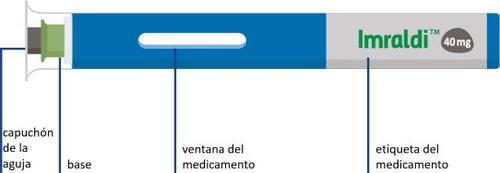
Ваша предварительно заполненная笔 не имеет кнопки.
Игла скрыта под зеленым основанием. Инъекция начнется автоматически, когда вы плотно прижмете предварительно заполненную笔 к коже.
Уход за вашей предварительно заполненной笔
Хранение笔
- Храните笔 в холодильнике, но не замораживайте.
- Держите笔 в коробке и защищайте от света.
- Держите笔 вне поля зрения и досягаемости детей.
Утилизация笔
- Используйте каждую笔 только один раз. Никогда не повторно используйте笔.
- Утилизируйте использованную笔 в специальном контейнере, как объяснил ваш врач, медсестра или фармацевт.
Предосторожности
- Если вы уронили笔 С защитным колпачком, вы можете использовать笔.
Если вы уронили笔 БЕЗ защитного колпачка, не используйте ее. Возможно, игла загрязнена или повреждена.
- Не используйте поврежденную笔.
Уход за местом инъекции
- Выберите зону с жиром для инъекции
Зоны с жиром, такие как живот, обычно являются лучшими местами для инъекции. Зоны с жиром хорошо подходят для правильного введения иглы.
- Используйте разное место для каждой новой инъекции
Когда вы выбираете место для инъекции, выберите место, которое вы не использовали недавно, чтобы не было боли или синяков.
Как вводить с помощью вашей предварительно заполненной笔
- Соберите необходимые материалы для инъекции
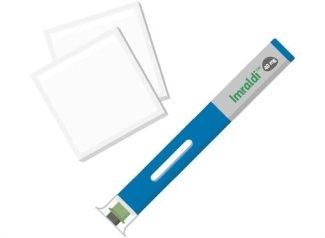
Поместите предварительно заполненную笔 и салфетки с алкоголем на чистую и сухую поверхность.
- Не забудьте вымыть руки!
- Не снимайте еще защитный колпачок!
- Подождите 15-30 минут
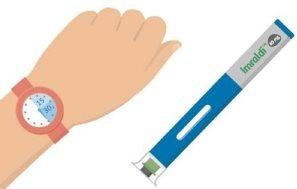
Подождите 15-30 минут, чтобы предварительно заполненная笔 достигла комнатной температуры; это помогает уменьшить боль во время инъекции.
- Не снимайте еще защитный колпачок!
- Проверьте препарат и срок годности
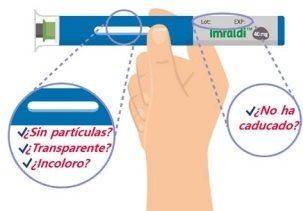
Убедитесь, что препарат прозрачный или опалесцирующий, бесцветный или светло-коричневый, не содержит частиц и не просрочен. Если препарат не прозрачный или опалесцирующий, бесцветный или светло-коричневый, содержит частицы или просрочен, не используйте его.
Возможно, вы увидите одну или несколько пузырьков воздуха, это нормально и не является причиной для отказа от препарата.
- Не снимайте еще защитный колпачок!
- Выберите место инъекции и очистите кожу
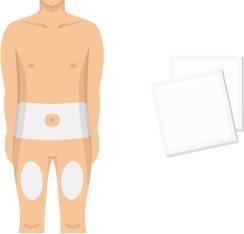
Выберите место инъекции на вашем теле. Наиболее подходящими зонами являются живот (кроме зоны вокруг пупка) и бедра.
Очистите место инъекции салфеткой с алкоголем. Не трогайте эту зону снова перед инъекцией.
- Избегайте зон кожи, которые болят, имеют синяки, шрамы, чешуйки или красные пятна.
- Снимите прозрачный защитный колпачок с иглы
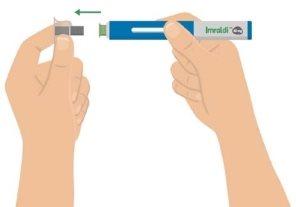
Снимите с помощью笔 прозрачный защитный колпачок с металлическим наконечником.
Нормально, если из иглы выйдет несколько капель жидкости.
Если вы снимете защитный колпачок до того, как будете готовы к инъекции, не надевайте его обратно, потому что можете согнуть или повредить иглу. Вы можете случайно уколоться или浪费 препарат.
- Поместите зеленое основание, прижмите и удерживайте давление
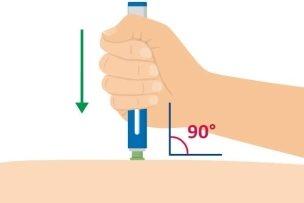
Поместите зеленое основание вертикально (под углом 90 градусов) на кожу и прижмите笔 вниз плотно, чтобы начать инъекцию.
Инъекция начинается, когда вы прижимаете вниз. Вы можете услышать первый щелчок.
- Удерживайте давление

Удерживайте笔 против кожи, пока желтый индикатор не заполнит окно препарата и не перестанет двигаться.
Через несколько секунд вы можете услышать второй щелчок.
- Подтвердите завершение и утилизируйте
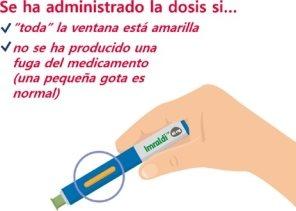
После введения препарата Имралди подтвердите, что все окно желтое.
Утилизируйте использованную笔 в специальном контейнере, как объяснил ваш врач, медсестра или фармацевт.
Не уверены, ввели ли вы полную дозу? Свяжитесь с вашим врачом, медсестрой или фармацевтом.
- Страна регистрации
- Активное вещество
- Требуется рецептДа
- Производитель
- Информация носит справочный характер и не является медицинской рекомендацией. Перед приемом любых препаратов проконсультируйтесь с врачом. Oladoctor не несет ответственности за медицинские решения, принятые на основе этого контента.
- Аналоги ИМРАЛДИ 40 мг РАСТВОР ДЛЯ ИНЪЕКЦИЙ В ПРЕДНАПОЛНЕННОМ ШПРИЦ-РУЧКЕФорма выпуска: ИНЪЕКЦИОННЫЙ РАСТВОР, 20 мгАктивное вещество: АдалимумабПроизводитель: Amgen Europe B.V.Требуется рецептФорма выпуска: ИНЪЕКЦИОННЫЙ РАСТВОР, 20 мгАктивное вещество: АдалимумабПроизводитель: Amgen Europe B.V.Требуется рецептФорма выпуска: ИНЪЕКЦИОННЫЙ РАСТВОР, 40 мгАктивное вещество: АдалимумабПроизводитель: Amgen Europe B.V.Требуется рецепт
Аналоги ИМРАЛДИ 40 мг РАСТВОР ДЛЯ ИНЪЕКЦИЙ В ПРЕДНАПОЛНЕННОМ ШПРИЦ-РУЧКЕ в других странах
Лучшие аналоги с тем же действующим веществом и терапевтическим эффектом.
Аналог ИМРАЛДИ 40 мг РАСТВОР ДЛЯ ИНЪЕКЦИЙ В ПРЕДНАПОЛНЕННОМ ШПРИЦ-РУЧКЕ в Україна
Врачи онлайн по ИМРАЛДИ 40 мг РАСТВОР ДЛЯ ИНЪЕКЦИЙ В ПРЕДНАПОЛНЕННОМ ШПРИЦ-РУЧКЕ
Консультация по дозировке, побочным эффектам, взаимодействиям, противопоказаниям и продлению рецепта на ИМРАЛДИ 40 мг РАСТВОР ДЛЯ ИНЪЕКЦИЙ В ПРЕДНАПОЛНЕННОМ ШПРИЦ-РУЧКЕ – по решению врача и с учетом местных правил.



